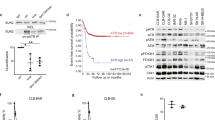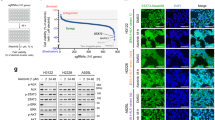Abstract
Abnormal expression of anaplastic lymphoma kinase (ALK) gene is an important pathogenic factor for anaplastic large cell lymphoma (ALCL). To study the function of ALK, an inducible short hairpin RNA (shRNA) system was stably introduced into cultured human ALCL cells. Inducing shRNA expression in the generated cells resulted in cellular ALK gene silencing and led to inactivation of multiple signaling pathways and growth arrest. Interestingly, a combination of ALK gene silencing with U0126, a kinase inhibitor specific for the extracellular signal-regulated kinases 1/2 pathway, resulted in an augmented reduction in cellular JunB expression. Functional studies indicated that combining ALK gene silencing with U0126 treatment provided a synergistic growth inhibition, which occurred faster and was more profound than with either treatment alone. This synergistic effect was also observed when measuring cell proliferation, apoptosis, and in vitro cell colony formation. Importantly, the combination of ALK gene silencing and U0126 had a prolonged inhibitory effect, preventing recovery of ALCL cell growth even after treatments were removed. Moreover, this synergistic inhibitory effect was confirmed in vivo using a mouse model with xenografted ALCL tumors. Our findings indicate that combining cellular ALK gene silencing with a low dose of U0126 may prove to be an effective and more specific therapeutic approach to treating ALCL.
This is a preview of subscription content, access via your institution
Access options
Subscribe to this journal
Receive 12 print issues and online access
$259.00 per year
only $21.58 per issue
Buy this article
- Purchase on Springer Link
- Instant access to full article PDF
Prices may be subject to local taxes which are calculated during checkout







Similar content being viewed by others
References
Stein H, Foss HD, Dürkop H, Marafioti T, Delsol G, Pulford K et al. CD30+ anaplastic large cell lymphoma: a review of its histopathologic, genetic, and clinical features. Blood 2000; 96: 3681–3695.
Delsol G, Jaffe ES, Faini B, Gascoyne RD, Muller-Hermelink HK, Stein H et al. Anaplastic large cell lymphoma (ALCL), ALK positive. In: Swerdlow SH, Campo E, Harris NL, Jaffe ES, Pileri SA, Stein H, Thiele J, Vardiman JW (eds). WHO Classification of Tumors of Haematopoietic and Lymphod Tissues. WHO Press: Lyon, 2008, pp 312–316.
Morris SW, Kirstein MN, Valentine MB, Dittmer KG, Shapiro DN, Saltman DL et al. Fusion of a kinase gene, ALK, to a nucleolar protein gene, NPM, in non-Hodgkin's lymphoma. Science 1994; 263: 1281–1284.
Morris SW, Naeve C, Mathew P, James PL, Kirstein MN, Cui X et al. ALK, the chromosome 2 gene locus altered by the t(2;5) in non-Hodgkin's lymphoma, encodes a novel neural receptor tyrosine kinase that is highly related to leukocyte tyrosine kinase (LTK). Oncogene 1997; 14: 2175–2188.
Duyster J, Bai RY, Morris SW . Translocations involving anaplastic lymphoma kinase (ALK). Oncogene 2001; 20: 5623–5637. Review.
Fujimoto J, Shiota M, Iwahara T, Seki N, Satoh H, Mori S et al. Characterization of the transforming activity of p80, a hyperphosphorylated protein in a Ki-1 lymphoma cell line with chromosomal translocation t(2;5). Proc Natl Acad Sci USA 1996; 93: 4181–4186.
Kuefer MU, Look AT, Pulford K, Behm FG, Pattengale PK, Mason DY et al. Retrovirus-mediated gene transfer of NPM-ALK causes lymphoid malignancy in mice. Blood 1997; 90: 2901–2910.
Chiarle R, Gong JZ, Guasparri I, Pesci A, Cai J, Liu J et al. NPM-ALK transgenic mice spontaneously develop T-cell lymphomas and plasma cell tumors. Blood 2003; 101: 1919–1927.
Amin HM, Lai R . Pathobiology of ALK+ anaplastic large-cell lymphoma. Blood 2007; 110: 2259–2267. Review.
Shulman LN, Frisard B, Antin JH, Wheeler C, Pinkus G, Magauran N et al. Primary Ki-1 anaplastic large-cell lymphoma in adults: clinical characteristics and therapeutic outcome. J Clin Oncol 1993; 11: 937–942.
Reiter A, Schrappe M, Tiemann M, Parwaresch R, Zimmermann M, Yakisan E et al. Successfull treatment strategy for Ki-1 anaplastic large-cell lymphoma of childhood: a prospective analysis of 62 patients enrolled in three consecutive Berlin-Frankfurt-Munster group studies. J Clin Oncol 1994; 12: 899–908.
Hannon GJ . RNA interference. Nature 2002; 418: 244–251. Review.
Zamore PD . Ancient pathways programmed by small RNAs. Science 2002; 296: 1265–1269.
Ritter U, Damm-Welk C, Fuchs U, Bohle RM, Borkhardt A, Woessmann W . Design and evaluation of chemically synthesized siRNA targeting the NPM-ALK fusion site in anaplastic large cell lymphoma (ALCL). Oligonucleotides 2003; 13: 365–373.
Piva R, Chiarle R, Manazza AD, Taulli R, Simmons W, Ambrogio C et al. Ablation of oncogenic ALK is a viable therapeutic approach for anaplastic large-cell lymphomas. Blood 2006; 107: 689–697.
Hsu FY, Zhao Y, Anderson WF, Johnston PB . Downregulation of NPM-ALK by shRNA causes anaplastic large cell lymphoma cell growth inhibition and augments the anti cancer effects of chemotherapy in vitro. Cancer Invest 2007; 25: 240–248.
Favata MF, Horiuchi KY, Manos EJ, Daulerio AJ, Stradley DA, Feeser WS et al. Identification of a novel inhibitor of mitogen-activated protein kinase kinase. J Biol Chem 1998; 273: 18623–18632.
Morgan R, Smith SD, Hecht BK, Christy V, Mellentin JD, Warnke R et al. Lack of involvement of the c-fms and N-myc genes by chromosomal translocation t(2;5)(p23;q35) common to malignancies with features of so-called malignant histiocytosis (SUDHL-1). Blood 1989; 73: 2155–2164.
Bai RY, Ouyang T, Miething C, Morris SW, Peschel C, Duyster J . Nucleophosmin-anaplastic lymphoma kinase associated with anaplastic large-cell lymphoma activates the phosphatidylinositol phosphatidylinositol 3-kinase/Akt antiapoptotic signaling pathway. Blood 2000; 96: 4319–4327.
Zamo A, Chiarle R, Piva R, Howes J, Fan Y, Chilosi M et al. Anaplastic lymphoma kinase (ALK) activates Stat3 and protects hematopoietic cells from cell death. Oncogene 2002; 21: 1038–1047.
Chiarle R, Simmons WJ, Cai H, Dhall G, Zamo A, Raz R et al. Stat3 is required for ALK-mediated lymphomagenesis and provides a possible therapeutic target. Nat Med 2005; 11: 623–629.
Watanabe M, Sasaki M, Itoh K, Higashihara M, Umezawa K, Kadin ME et al. JunB induced by constitutive CD30-extracellular signal-regulated kinase 1/2 mitogen-activated protein kinase signaling activates the CD30 promoter in anaplastic large cell lymphoma and reed-sternberg cells of Hodgkin lymphoma. Cancer Res 2005; 65: 7628–7634.
Milella M, Kornblau SM, Estrov Z, Carter BZ, Lapillonne H, Harris D et al. Therapeutic targeting of the MEK/MAPK signal transduction module in acute myeloid leukemia. J Clin Invest 2001; 108: 851–859.
Horiuchi H, Kawamata H, Fujimori T, Kuroda Y . A MEK inhibitor (U0126) prolongs survival in nude mice bearing human gallbladder cancer cells with K-ras mutation: analysis in a novel orthotopic inoculation model. Int J Oncol 2003; 23: 957–963.
Dai Y, Chen S, Pei XY, Almenara JA, Kramer LB, Venditti CA et al. Interruption of the Ras/MEK/ERK signaling cascade enhances Chk1 inhibitor-induced DNA damage in vitro and in vivo in human multiple myeloma cells. Blood 2008; 112: 2439–2449.
Wentz SC, Wu H, Yip-Schneider MT, Hennig M, Klein PJ, Sebolt-Leopold J et al. Targeting MEK is effective chemoprevention of hepatocellular carcinoma in TGF-alpha-transgenic mice. J Gastrointest Surg 2008; 12: 30–37.
Rinehart J, Adjei AA, Lorusso PM, Waterhouse D, Hecht JR, Natale RB et al. Multicenter phase II study of the oral MEK inhibitor, CI-1040, in patients with advanced non-small-cell lung, breast, colon, and pancreatic cancer. J Clin Oncol 2004; 22: 4456–4462.
Lorusso PM, Adjei AA, Varterasian M, Gadgeel S, Reid J, Mitchell DY et al. Phase I and pharmacodynamic study of the oral MEK inhibitor CI-1040 in patients with advanced malignancies. J Clin Oncol 2005; 23: 5281–5293.
Adjei AA, Cohen RB, Franklin W, Morris C, Wilson D, Molina JR et al. Phase I pharmacokinetic and pharmacodynamic study of the oral, small-molecule mitogen-activated protein kinase kinase 1/2 inhibitor AZD6244 (ARRY-142886) in patients with advanced cancers. J Clin Oncol 2008; 26: 2139–2146.
Acknowledgements
This study was supported in part by research funding from the Methodist Hospital Research Institute (CTSA) and grants from the National Cancer Institutes (1K22CA113493 and 5P50CA126752).
Author information
Authors and Affiliations
Corresponding author
Ethics declarations
Competing interests
The authors declare no conflict of interest.
Additional information
Supplementary Information accompanies the paper on Cancer Gene Therapy website
Supplementary information
Rights and permissions
About this article
Cite this article
Ito, M., Zhao, N., Zeng, Z. et al. Synergistic growth inhibition of anaplastic large cell lymphoma cells by combining cellular ALK gene silencing and a low dose of the kinase inhibitor U0126. Cancer Gene Ther 17, 633–644 (2010). https://doi.org/10.1038/cgt.2010.20
Received:
Revised:
Accepted:
Published:
Issue Date:
DOI: https://doi.org/10.1038/cgt.2010.20
Keywords
This article is cited by
-
Recombinant expression, characterization, and quantification in human cancer cell lines of the Anaplastic Large-Cell Lymphoma-characteristic NPM-ALK fusion protein
Scientific Reports (2020)
-
Constitutive control of AKT1 gene expression by JUNB/CJUN in ALK+ anaplastic large-cell lymphoma: a novel crosstalk mechanism
Leukemia (2015)
-
NPM-ALK signals through glycogen synthase kinase 3β to promote oncogenesis
Oncogene (2012)
-
Transfection of shRNA-encoding Minivector DNA of a few hundred base pairs to regulate gene expression in lymphoma cells
Gene Therapy (2011)



